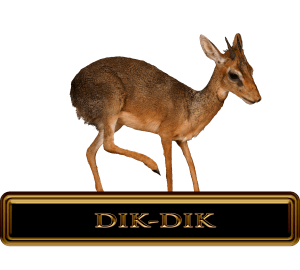
Legacy Outdoors Dik-dik Hunts are high success and are with the very best outfitters in Africa! The Dik- Dik is a tiny antelope and has very unique characteristics. Dik Dik are easily recognized by their odd looking nose, they have what is referred to as a mobile nose meaning they can actually consciously move their nose. They come in different shades from light sand color to darker speckled coats. Their color depends on the terrain they’re found in from semi desert areas to more dense grassland regions.
There are four recognised Dik Dik species which can be hunted and recorded into record books; they are the Gunther’s dik-dik, the Kirks dik-dik, Silver dik-dik and Salt’s dik-dik. In the past there have been other subspecies of dik dik noted but these are not true sub species and actually just fall in as colour variants of the main sun species.
The Salts dik-dik can be taken in the lowland lying areas of Ethiopia. The Omo Valley and Danakil are known for their good dik-dik trophies. The dik-dik hunted in these areas differs in appearance according to the elevation and habitat in which they are found. They are however all recorded as a Salts dik-dik
The Gunther’s dik-dik can also be Ethiopia but is distinctly different in appearance to the salts dik-dik. The Gunther’s tends to have a slightly longer leaner neck when compared to the salts. Although for the first timer, it will be incredibly difficult to spot the difference between all the dik dik species. Gunther’s dik-dik is also available for hunters in scattered populations throughout Uganda.
The Kirks dik-dik can be taken in Tanzania, they are available on 16 and 21 day hunting licences.
In Northern and northern-central Namibia you can hunt the Damara dik dik. The Damara is technically a sub species of the kirks dik-dik but due to Rowland Wards record of Big Game and Safari Club International listing it as a species on its own- we will do the same.
Hunting dik dik is most often done when the opportunity arises. They are extremely small animals and one needs to be very alert and vigilant when trying to spot a dik dik in the field. Dik dik blend in very well with their environment and are tricky to spot unless they move. Often while out hunting other species a dik dik may be spotted or bumped. Another successful way to hunt dik dik is to walk and stalk in the habitat where they are known to feed. Dik dik will feed early morning and late afternoon and usually drink around midday. After drinking dik dik rest until the heat of the day has passed. Due to their nature dik dik are relatively easy prey for predators in the areas where they occur. Dik dik are hunted by caracal, leopard, lion and wild dogs. In areas that are under pressure one will have to look very hard for signs that they are there and may need to be tracked when hunted.
Only male dik-dik have horns, and they can sometimes be tricky to see amongst the tuft of hair which grows in-between their ears. A good dik dik trophy will have horns which are almost as long as the ears and sometimes longer. Thick bases will also help him to score well.
When hunting dik dik it is wise to use a solid bullet to prevent damaging the trophy. A solid bullet out of a high powered rifle will pass straight through making only two small holes in the cape. Some PHs may even recommend using a shotgun with buckload or a centre fire calibre in the .22 Hornet range which has proven to be very successful.
If you are looking for a great Dik-dik hunt, give us a call or fill out the form below and let us help you find the perfect dik-dik hunt for you.
Legacy Outdoors
Offices In:
Idaho, Wisconsin, Alberta, Illinois, Texas, Pennsylvania